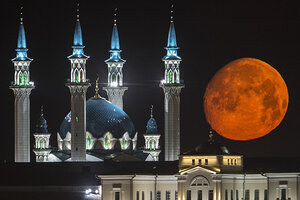Blue moon: What is a blue moon and where can you see it?
Blue moon: An extra full moon on Friday will give astronomers, professional and amateur alike, the chance to look skyward once again.

The full moon rises over the illuminated Kazan Kremlin with the Qol Sharif mosque illuminated in Kazan, the capital of Tatarstan, located in Russia's Volga River area 450 miles east of Moscow, early Wednesday, July, 29, 2015.
Denis Tyrin/AP
Turn your eyes to the skies Friday morning for a rare cosmic event that occurs, well, once in a blue moon.
July 31 marks the second full moon of the calendar month, also known as the "blue" moon.
Typically, the Earth experiences 12 full moons each year, one in each month. But some years have 13 full moons, and one of those extra moons is called a blue moon.
This happens because the lunar month averages about 29.53 days, according to Space.com. This is shorter than most calendar months, so the extra days accumulate throughout the year, eventually resulting in 13 full moons some years.
The blue moon occurs roughly once every 2.7 years, but if you blink, you'll miss it. While most observers perceive the full moon as lasting one night, technically it's an instantaneous event that occurs when the earth, moon, and sun fall in a straight line.
If you want to catch the true blue moon this Friday, turn your gaze on the moon at exactly 6:43 a.m. EDT.
As you're pondering the glowing orb, consider this: What we now consider a blue moon is the result of a historic mistake. The blue moon was originally defined by the Maine Farmers' Almanac as the third full moon in a three-month season that has four moons rather than the usual three.
In a 1946 article, Sky & Telescope Magazine misinterpreted that definition as the second full moon in a calendar month, which is how it is defined today. Friday's blue moon is the second full moon in July. The first occurred July 2, the second will be July 31.
Despite its moniker, the blue moon isn't actually blue. Some have posited that the name comes from the Old English word "belewe," meaning to betray, because the blue moon betrays the usual one full moon per month norm, by which farmers once marked the changing of seasons.
And while the blue moon isn't actually blue, it may look blue to some observers. In fact, any moon can be blue if a volcanic eruption, forest fire, wildfire or other event blows a significant amount of ash into the atmosphere. That's because particles from the smoke or ash are about as wide as the wavelength of red light, which means they scatter red light but allow blue light to pass through. The particles act as a blue filter, and earthly observers perceive the moon as blue.
The blue moon really does only occur once in a blue moon, however, so lunar fans should set their alarms Friday morning. The next blue moon won't occur until 2018.


